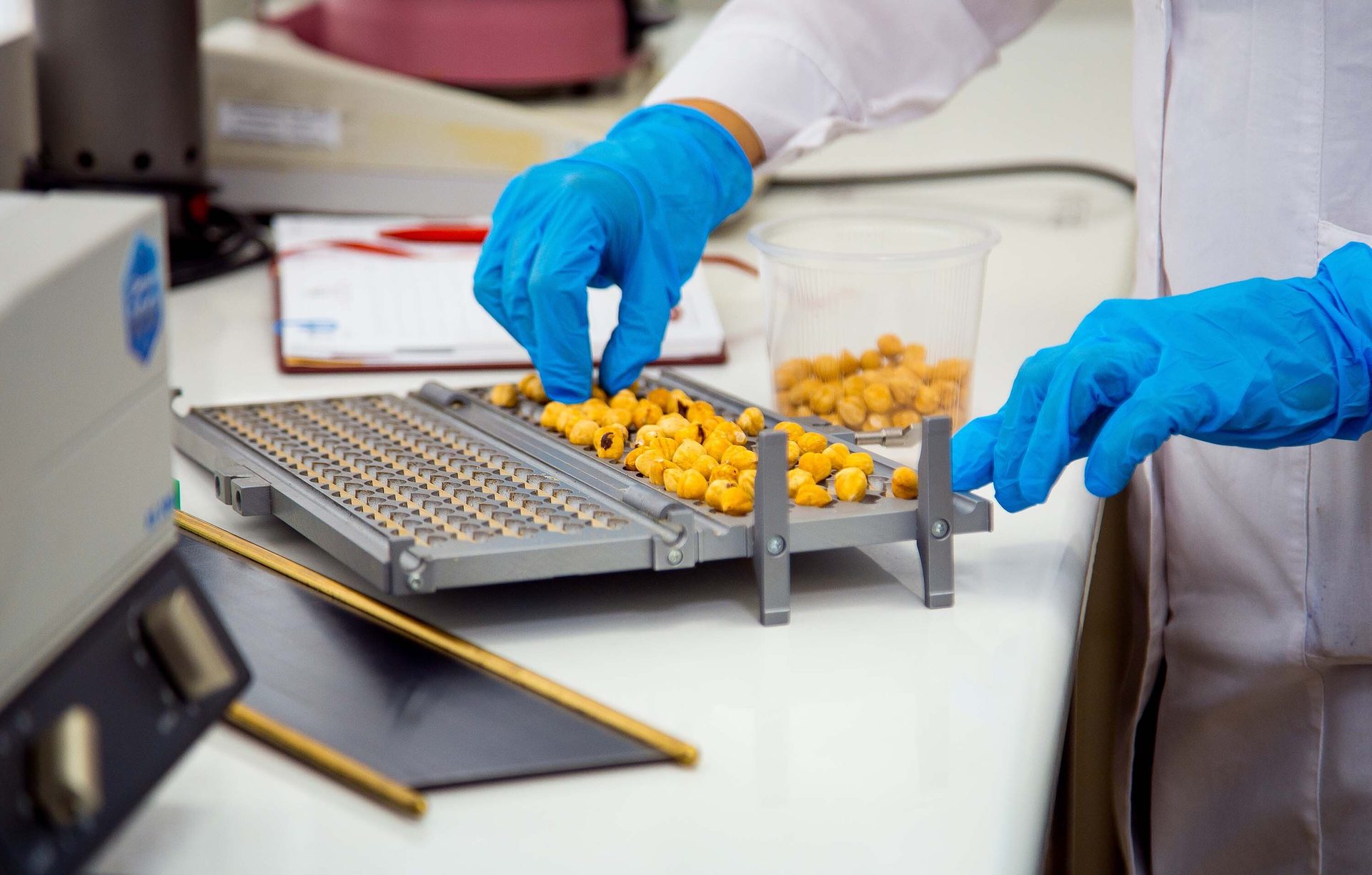PFAS
Unmasking 'Forever Chemicals': Global Insights on PFAS and Urgent Calls to Action—Part 1
The delayed response and mismanagement of PFAS and plastic waste have led to severe consequences for human health
By Jocelyn C. Lee, Food Safety Consultant, Gourmet In Motion; John Duffill, CEO, John Crop Development Vietnam; Ben Marandi, Ph.D., Food Scientist, Researcher, and Food Policy and Legal Advisor; Slim Smaoui, Ph.D., Professor, Center of Biotechnology of Sfax; and Theodoros Varzakas, Ph.D., Professor, Department of Food Science and Technology, University of Peloponnese
SCROLL DOWN
Video credit: RamilF/Creatas Video+/Getty Images Plus via Getty Images
> SPOtliGHT
Since the 1940s, synthetic chemicals like per-fluorooctanoic acid (PFOA) and other per- and polyfluoroalkyl substances (PFAS) have been utilized for their oil- and water-repellent properties in various consumer and industrial products (Figure 1). Their durability and resistance to degradation result in their persistence in the environment and the human body, leading to widespread contamination. Major chemical companies have shaped regulations and public perception, delaying stricter regulations and permitting the continued use of these harmful substances in food packaging and other materials.1
FIGURE 1. Timeline of PFAS Development and Impact (1938–Present) in the U.S.2
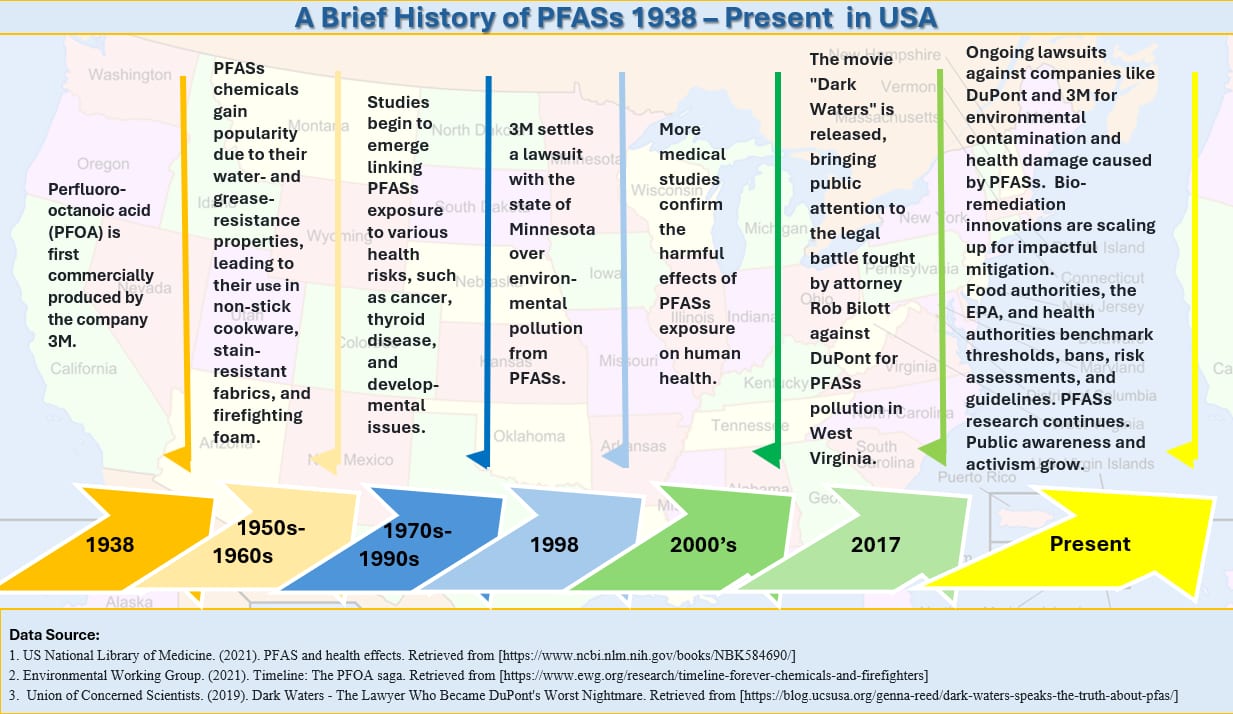
PFAS and Microplastics: A Double-Edged Sword for Public Health
PFAS and microplastics are two major environmental pollutants that are often studied separately; yet, their combined impact is increasingly critical for public health, consumer awareness, and environmental sustainability.
PFAS are synthetic chemicals used in industrial processes and consumer products (e.g., food packaging, nonstick cookware, stain-resistant fabrics, firefighting foams, etc.). Their persistence in the environment has earned them the nickname "forever chemicals." Microplastics are plastic fragments measuring under 5 mm, typically resulting from larger plastics or microbeads in personal care items. Present in oceans, freshwater, soil, and human tissues, microplastics absorb chemicals, including PFAS.3,4
Studies show that microplastics can carry PFAS through ecosystems, leading to bioaccumulation and biomagnification that increase exposure risks for organisms at higher trophic levels, including humans.5,6,7 The interaction between PFAS and microplastics poses serious public health concerns, with seafood consumption being a primary exposure route in marine environments.8 Their combined presence also creates significant environmental challenges, as PFAS-bound microplastics disperse widely, threatening wildlife by disrupting reproductive and hormonal systems and causing physical harm from ingestion.9
Raising consumer awareness is crucial. Reducing exposure to PFAS and microplastics can be achieved by avoiding products containing them (e.g., food packaging, nonstick cookware, and single-use plastics). Policy measures, such as banning PFAS in consumer goods and enforcing stricter plastic use regulations, are essential to mitigate this threat.2
Stalled Solutions and Rising Costs: The Human Toll of PFAS Mismanagement
The delayed response and mismanagement of PFAS and plastic waste have led to severe consequences for human health. Communities near manufacturing sites have higher rates of cancer, thyroid disease, and other health issues linked to PFAS exposure. The economic burden of healthcare costs and environmental cleanup is staggering, with estimates running into trillions of U.S. dollars.10,11,12
The nexus between PFAS and microplastics represents a complex environmental and public health challenge. As research continues to demonstrate the interactions and impacts of these contaminants, informed policies and consumer practices are necessary to address the pervasive threat they pose to health and the environment.2
PFAS and Long-Term Health Effects
PFAS compounds are environmentally persistent, raising substantial ecological concerns and posing significant health risks that have been documented worldwide. Long-term exposure to PFAS can induce reproductive toxicity, hepatotoxicity, and metabolic disorders affecting the blood, liver, and kidneys.13–20 Long-chain PFAS are linked to cardiovascular disease, immune system disorders, and cholesterol metabolism.21,22 HFPO-DA, used in the manufacture of so-called "GenX chemicals," is a replacement for long-chain PFOA, but it can still accumulate in the human body.23–27 In children, PFOA exposure is associated with increased asthma risk, and PFOS is linked to impaired lung function. Children's behaviors (e.g., hand-to-mouth activities, crawling) increase exposure through inhalation, ingestion (dust, soil, water, food, breast milk), and dermal contact. Higher PFAS levels in children's blood serum than in adults have been documented.28–32
PFAS are highly persistent endocrine-disrupting chemicals with extreme thermal and chemical stability. Exposure to certain PFAS may raise the odds of endometriosis in females.33–38 PFAS can enter the body through drinking water and diet, and studies have detected PFAS in the placenta, breast milk, follicular fluid, and meconium. High concentrations of PFOS, PFOA, PFNA, and PFHxS have been observed in pregnant women and children.39–52 Certain PFAS may also be positively associated with periodontitis, potentially mediated by sex hormones such as testosterone and the testosterone-to-estradiol ratio.53
“Various analytical techniques have proven useful for PFAS assessment. These tools must be designated prudently according to the application, the medium, and the desired detection limit.”
Research in the U.S. also links serum PFAS concentrations (PFOA, PFNA, PFDA, PFHxS, PFOS) to hyperlipidemia in adults. Similar investigations have been conducted in India, Israel, and Italy.54–57 The European Food Safety Authority (EFSA) highlights reduced vaccine antibody response in children due to PFAS exposure, setting a TWI of 4.4 ng/kg body weight for the four major PFAS compounds (PFOA, PFOS, PFNA, PFHxS).58
Measuring PFAS Concentrations
Recent studies on PFAS have primarily been conducted in China and Europe, with few in the U.S. and Australia. Many analytical techniques have been employed to completely describe samples and check the presence and PFAS concentrations.59,60 High-performance liquid chromatography (HPLC), coupled with tandem mass spectrometry (MS/MS), is designated as a main detection and level determination tool for PFAS, which is regulated by the U.S. Environmental Protection Agency (EPA).61
Additionally, particle-induced gamma ray emission (PIGE) spectroscopy, a non-destructive surface analysis technique, has been utilized to quantify PFAS in medical and biological applications.62 Adsorbable organic fluorine assay is another technique that can quantify organic PFAS based on combustion ion chromatography. Total oxidizable precursor assay is a valuable process for PFAS detection,63 although this method is limited to compounds that can be oxidized to form targeted perfluoroalkyl acids.
In brief, various analytical techniques have proven useful for PFAS assessment. These tools must be designated prudently according to the application, the medium, and the desired detection limit.2
PFAS Risks, Mitigation, and Regulatory Needs
Widespread PFAS contamination of food and drinking water poses significant public health risks. Addressing this issue requires strict regulations, ongoing monitoring, and innovative solutions to protect ecosystems and ensure safer consumption for future generations.64
Public awareness of PFAS exposure is critical. Consumers should be informed about the risks of certain food packaging and encouraged to choose safer options, like home-cooked meals with fresh ingredients, to minimize toxin exposure. Public education on chemical contaminants and reduction strategies should be part of a risk mitigation approach. Collaboration among governments and organizations is also necessary to create consistent safety standards, especially for vulnerable populations in developing countries. Investment in research on safer packaging alternatives is essential.
Enhanced monitoring of food products can help detect contamination and prevent hazardous items from reaching consumers. PFAS contamination of food and water underscores the necessity of effective mitigation and stringent regulations to protect public health. This information informed the authors' survey project on varying regulatory responses and awareness levels worldwide.
PFAS on the World Stage: A Global Survey
Part 1 of the authors' worldwide survey on PFAS awareness and response gathered information about various governance and regulatory enforcement issues related to environmental and health concerns associated with PFAS. Figure 2 shows the regions and countries represented in the survey.
FIGURE 2. Continents, Countries, and Regions Represented
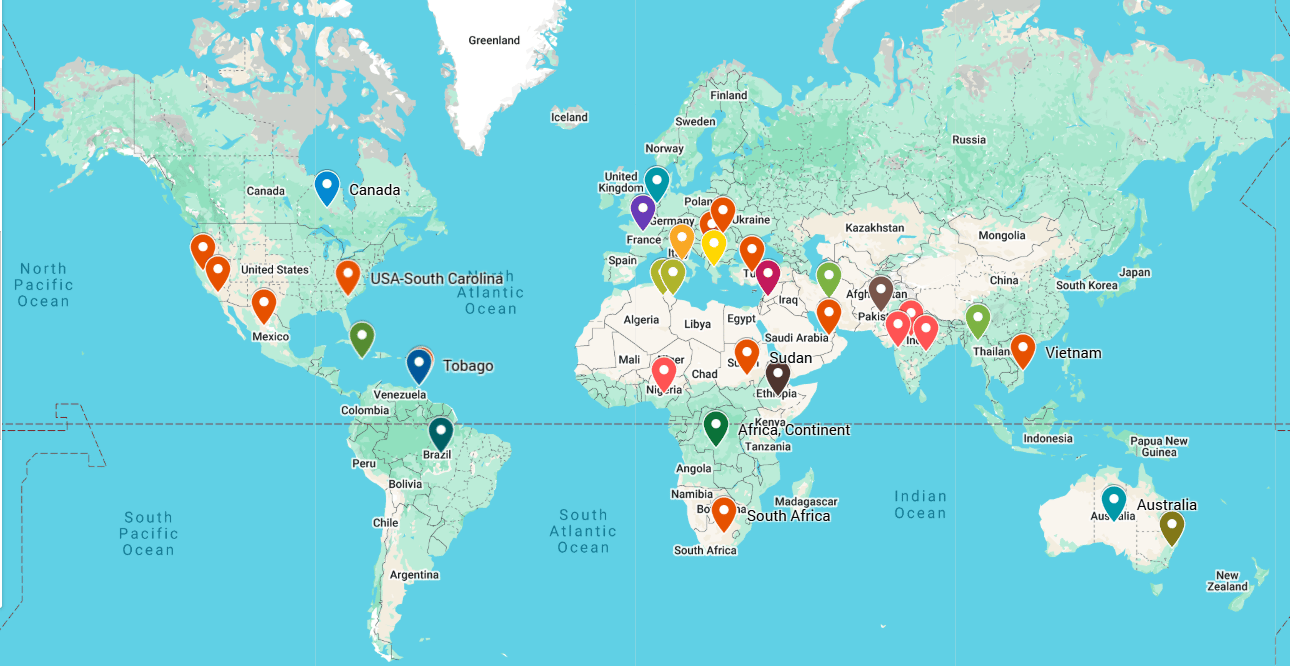
In Part 1 of the survey, categories and questions regarding PFAS awareness and enforcement included the following:
- Governance and regulatory enforcement: Do you believe your government is actively engaged in regulating PFAS usage and management?
- Public awareness: Are there clear guidelines in your country for industries on PFAS handling and disposal? Have public awareness campaigns about PFAS been conducted in your region?
- Bioremediation innovations: Are there initiatives in your country to develop innovative solutions for PFAS bioremediation?
- Drinking water quality management: Is the drinking water in your area regularly tested for PFAS contamination? Do you trust the management of drinking water quality in terms of safety from PFAS contamination?
- Maximum residue levels (MRL) thresholds: Has your country established MRL thresholds for PFAS in food products?
- Bans on PFAS: Are there bans or restrictions on the use of PFAS in food packaging in your country? Are PFAS banned or restricted in pesticides used in your area? Is there a prohibition on PFAS contamination in waterways where you live?
- International support and knowledge sharing: Is your country part of any international collaborations regarding PFAS research or management? Have you seen improvements in PFAS management due to international knowledge-sharing?
- Long-term health effects studies on PFAS: Are studies being conducted in your region to understand the long-term health effects of PFAS exposure? Do you consider PFAS a critical public health issue in your community?
Part 2 of the survey gathered more information about public awareness and concerns regarding PFAS, as well as their impact on health risks and various environmental issues. Categories and questions regarding PFAS awareness and health concerns in Part 2 included the following:
- Is the public in your country/region aware of the terms "PFAS" or "forever chemicals?"
- Do you believe that PFAS contamination is a significant issue in landfill management?
- Are you concerned about the quality of groundwater in your area due to PFAS?
- Do you think that "plastic islands" in oceans may contain PFAS compounds?
- Are you worried about PFAS exposure through air pollution?
- Do you believe that PFAS can contaminate soil?
- Are you concerned about the impact of PFAS on crop safety and quality?
- Do you think waterways are at risk of PFAS pollution in your region?
- Are you worried about PFAS contamination in fish that may be consumed?
- Do you believe that PFAS has harmful effects on marine life?
Survey Data and Discussion
Aggregated data on global PFAS activities and awareness are shown in Figure 3a and 3b for continents.
FIGURE 3. Aggregated Data on Global PFAS Activities and Awareness, by Continent
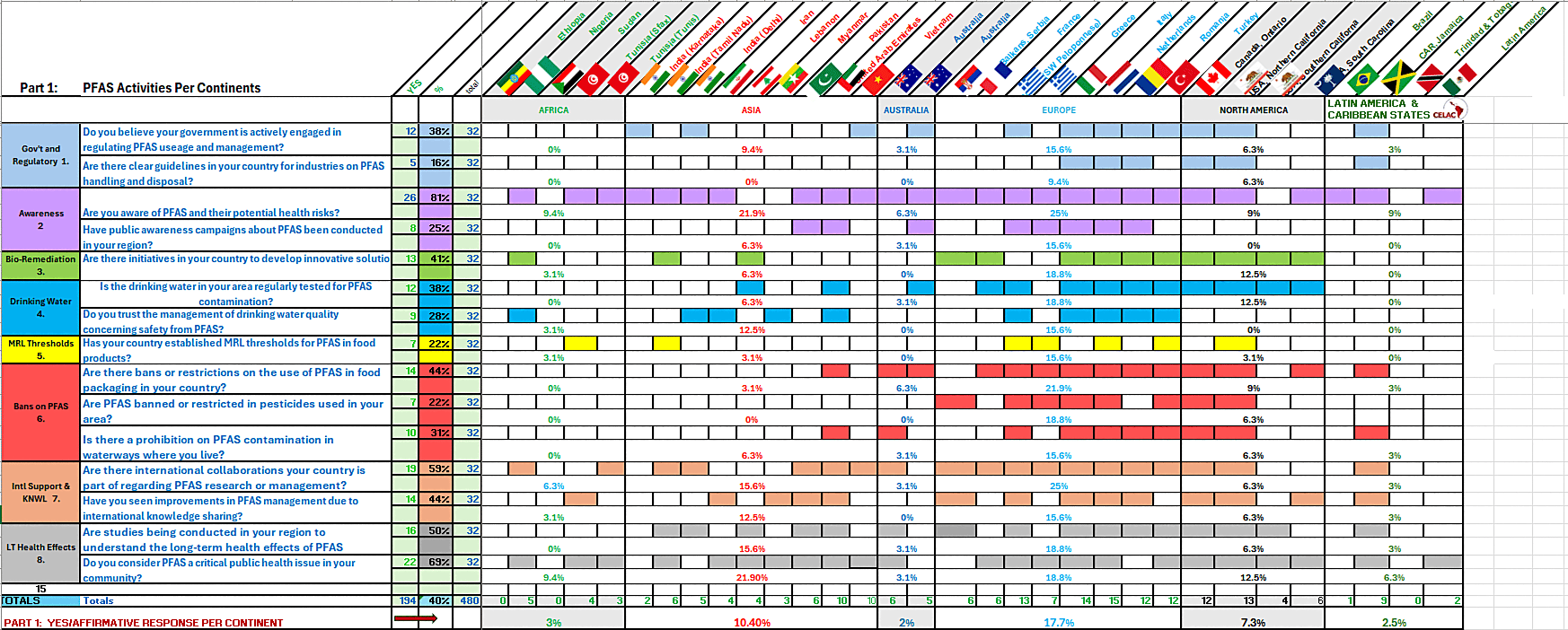

Aggregated data on global PFAS activities and awareness are shown in Figure 4a and 4b for developing and developed regions.
FIGURE 4. Aggregated Data on Global PFAS Activities and Awareness, by Developing and Developed Region
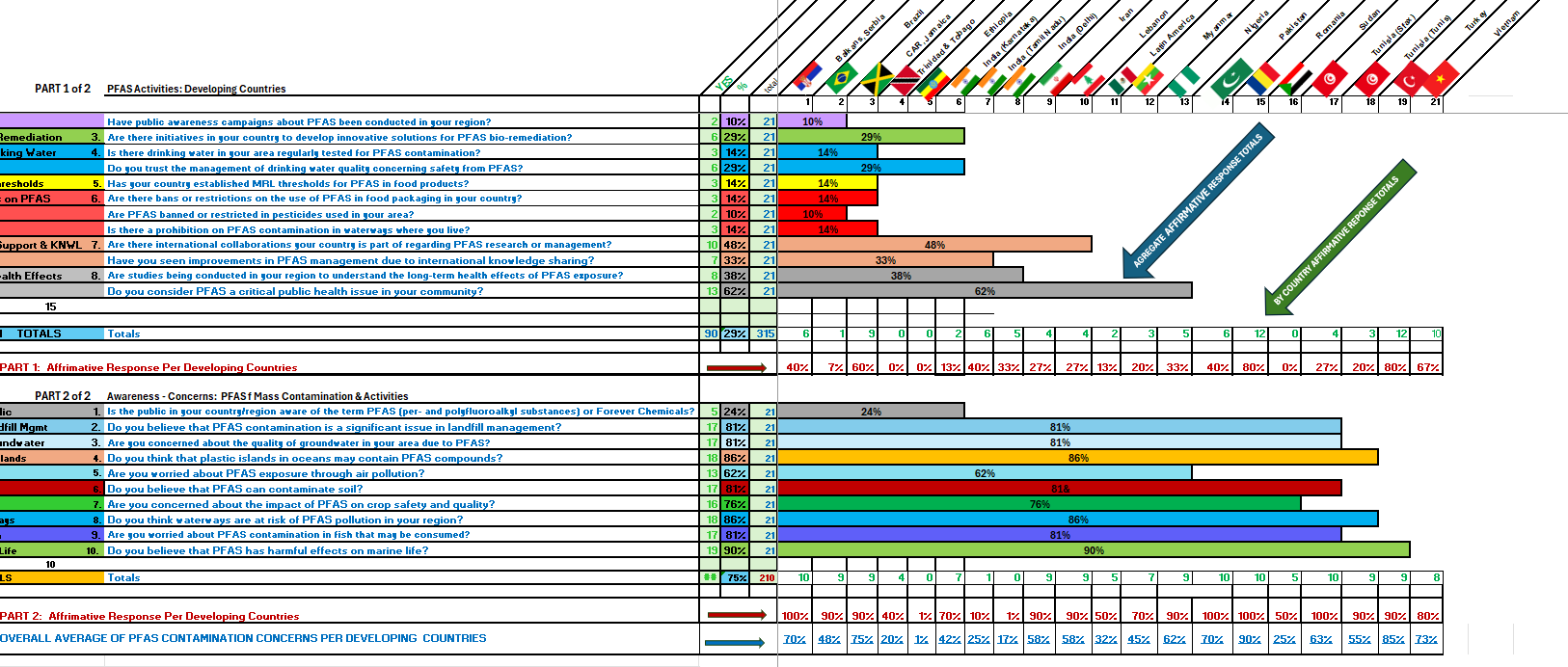

As discussed, the survey measured governance and regulatory enforcement of PFAS for entire continents, developing regions, and developed regions, as shown in Table 1. The percentages indicate the portion of survey respondents who answered "yes."
TABLE 1. PFAS Governance and Regulatory Enforcement Worldwide
The survey also measured public awareness and concerns about PFAS for entire continents, developing regions, and developed regions, as discussed above and shown in Table 2. The percentages indicate the portion of survey respondents who answered "yes."
TABLE 2. PFAS Awareness and Concerns Worldwide
Survey Results and Recommendations
The results of the survey showed extremely low governance and regulatory enforcement of PFAS in developing regions:
- Only 10 percent of developing regions have guidelines for PFAS disposal, compared to 25 percent in developed regions.
- Only 10 percent of developing regions have public awareness campaigns, compared to 92 percent in developed regions.
- Only 14 percent of developing regions regularly test drinking water for PFAS contamination, compared to 50 percent in developed regions.
- Only 14 percent of developing regions have established MRL thresholds for PFAS in food products, compared to 33 percent in developed regions.
- Only 14 percent of developing regions have bans or restrictions on the use of PFAS in food packaging, compared to 92 percent in developed regions.
- Only 10 percent of developing regions have PFAS banned or restricted in pesticides, compared to 42 percent in developed regions.
The survey results also showed high public awareness and unexpectedly high concerns regarding PFAS:
- 84 percent of continents, 81 percent of developing regions, and 92 percent of developed regions believe that PFAS contamination is a significant issue in landfill management.
- 88 percent of continents, 81 percent of developing regions, and 92 percent of developed regions are concerned about the quality of groundwater due to PFAS.
- 84 percent of continents, 81 percent of developing regions, and 92 percent of developed regions believe that PFAS can contaminate soil.
- 81 percent of continents, 76 percent of developing regions, and 92 percent of developed regions are concerned about the impact of PFAS on crop safety and quality.
- 84 percent of continents, 86 percent of developing regions, and 83 percent of developed regions think waterways are at risk of PFAS pollution.
- 84 percent of continents, 81 percent of developing regions, and 92 percent of developed regions are worried about PFAS contamination in fish that may be consumed.
The survey data reveals that while public awareness campaigns for PFAS stand at 92 percent in developed regions, developing regions lag at just 10 percent. This gap underscores the immediate need for targeted educational campaigns and stricter policy interventions. Furthermore, the notable difference in PFAS bans or restrictions—14 percent in developing regions vs. 92 percent in developed regions—demonstrates an urgent need for technology transfer and international support to mitigate PFAS risks globally. The overwhelmingly high rate of concern regarding PFAS globally is notable.
Risks and Challenges
PFAS contamination of drinking water poses a major public health concern due to the chemicals' long-term persistence, bioaccumulation potential, and association with various health risks. While regulatory efforts to manage and reduce PFAS contamination are progressing, further advancements in technology and research investment are necessary. Safe drinking water is a fundamental human right, and addressing PFAS contamination is essential for community well-being.
Similarly, chemical contaminants in food—including PFAS, heavy metals, and endocrine disruptors—are growing concerns for human health. Variability in regulatory frameworks across regions exacerbates the problem, with some populations facing a higher risk of exposure to unsafe chemical levels. A global initiative is needed to enforce stricter regulations, drive technological innovation, and increase public awareness to mitigate these risks.2
“Governments and international organizations must collaborate to harmonize safety standards and regulatory frameworks to ensure uniform consumer protection across borders.”
Strategies for Mitigation
Various strategies for mitigation of PFAS include the following:
- Enhanced detection and monitoring: Chemical contaminant detection in food and water can be enhanced using advanced analytical technologies.
- Widespread adoption of PFAS test kits for rapid detection in industrial and home settings: Augmented food product monitoring throughout the supply chain can help detect contamination early and prevent the distribution of hazardous products.
- Innovative food packaging solutions: A transition is needed to safer packaging alternatives, such as glass, compostables, and sustainable non-plastics, to reduce chemical transfer into food. Industry investment is needed in research for biodegradable and non-toxic packaging materials to replace PFAS and BPA.
- Agricultural and water treatment improvements: Enhanced filtration systems for irrigation, post-harvest processes, and drinking water treatment must be developed. The implementation of innovative agricultural practices can help reduce pesticide usage and prevent contamination.
- Public awareness and consumer action: Education campaigns can inform consumers about chemical risks in food packaging and encourage safer choices. Consumers should be encouraged to use fresh ingredients for home-cooked meals to minimize exposure to processed food contaminants.
- Policy and regulatory alignment: Governments and international organizations must collaborate to harmonize safety standards and regulatory frameworks to ensure uniform consumer protection across borders. This alignment is particularly critical in developing nations, where regulatory oversight is often weaker.
The widespread presence of PFAS contamination in food and drinking water presents a significant public health challenge. The persistence and bioaccumulation of these chemicals highlight the urgent need for several actions:
- Stricter regulations and enforcement mechanisms
- Continuous monitoring and advanced detection methods
- Industry-wide shifts toward safer alternatives in food packaging
- Greater public education to reduce consumer exposure to harmful chemicals.
By prioritizing investment in research, aligning global safety standards, and fostering sustainable food production practices, we can mitigate the health risks associated with PFAS contamination and ensure a safer future for food and water consumption worldwide.2
Part 2 of this article, to be published in the August/September issue, will discuss the application of several problem-solving analytical tools to the PFAS crisis. Lastly, the impacts of PFAS on the United Nations' Sustainable Development Goals (SDGs) for 2030 will be discussed.
Acknowledgments
The authors acknowledge the contributions of the worldwide network of professionals listed below. We thank you for your insights in respect to the PFAS impact specific to your regions and populations.
Contributors (in alphabetical order by country and region)
Ajay Shah, Australia
Olanrewaju Olotu, Australia
Muntasib Tehseen, Australia
Carla Otsuki, Brazil
Ben Marandi, Canada
Desta T.L., Ethiopia
Francois Bourdichon, France
Dimitris Drivas, Greece
Theodoros Varzakas, Greece
Pranesh Badami, India
Vikash Kumar, India
Wasi Asghar, India
Valiollah Farhad Kasravi, Iran
Abdul Moiz, Italy
Marva Hewitt, Jamaica
Michael Manneh, Lebanon
Mario Echandi Bachtold,
Latin America
Saint Yi Htet, Myanmar
Kitty Appels, the Netherlands
Solomon Olusanya Oyeniran, Nigeria
Abid Hussain, Pakistan
Georgiana Munteanu, Romania
Veselina Pelagic, Serbia
Dejana Kulesevic, Serbia
Rajko Novakovic, Serbia
Mohamed Ibrahim Bala, Sudan
Devi Yankataso, Trinidad and Tobago
Slim Smaoui, Tunisia
Hrabi Nouredine, Tunisia
Ufuk Ayyildiz, Turkey
Lavanya Nidunapu, United Arab Emirates
Jonathan Needham, U.S.
Jocelyn Lee, U.S.
Michael Manneh, U.S.
John Duffill, Vietnam
References
- Interstate Technology Regulatory Council (ITRC). "History and Use of Per- and Polyfluoroalkyl Substances (PFAS) Found in the Environment." 2020. https://pfas-1.itrcweb.org/wp-content/uploads/2020/10/history_and_use_508_2020Aug_Final.pdf.
- Lee, J.C., S. Smaoui, J. Duffill, B. Marandi, and T. Varzakas. "Research Progress in Current and Emerging Issues of PFAS' Global Impact: Long-Term Health Effects and Governance of Food Systems." Foods 14, no. 6 (March 2025): 958. https://doi.org/10.3390/foods14060958.
- National Oceanic and Atmospheric Administration (NOAA). "What are Microplastics?" June 16, 2024. https://oceanservice.noaa.gov/facts/microplastics.html.
- Bakir, A., S.J. Rowland, and R.C. Thompson. "Competitive Sorption of Persistent Organic Pollutants Onto Microplastics in the Marine Environment." Marine Pollution Bulletin 64 (2012): 2782–2789.
- Wang, X., Y. Wang, J. Li, et al. "Occurrence and Dietary Intake of Perfluoroalkyl Substances in Foods of the Residents in Beijing, China." Food Additives & Contaminants: Part B 14 (2021): 1–11.
- Rochman, C.M., A. Tahir, S.L. Williams, et al. "Anthropogenic Debris in Seafood: Plastic Debris and Fibers from Textiles in Fish and Bivalves Sold for Human Consumption." Scientific Reports 5 (2015): 14340.
- Fossi, M.C., L. Marsili, M. Baini, et al. "Fin Whales and Microplastics: The Mediterranean Sea and the Sea of Cortez Scenarios." Environmental Pollution 209 (2016): 68–78.
- Toms, L.M.L., A.M. Calafat, K. Kato, et al. "Polyfluoroalkyl Chemicals in Pooled Human Serum from Australia in 2002, 2004, 2006, and 2008." Environmental Science & Technology Journal 43 (2009): 4194–4199.
- Teuten, E.L., J.M. Saquing, D.R. Knappe, et al. "Transport and Release of Chemicals from Plastics to the Environment and to Wildlife." Philosophical Transactions of the Royal Society B: Biological Sciences 364 (2009): 2027–2045.
- Merkl, A. and D. Charles. "The Price of Plastic Pollution: Social Costs and Corporate Liabilities." Minderoo Foundation. 2022. https://www.beyondplastics.org/reports/the-price-of-plastic-pollution.
- Minnesota Pollution Control Agency. "Groundbreaking Study Shows Unaffordable Costs of PFAS Cleanup from Wastewater." June 6, 2023. https://www.pca.state.mn.us/news-and-stories/groundbreaking-study-shows-unaffordable-costs-of-pfas-cleanup-from-wastewater.
- U.S. Environmental Protection Agency (EPA). "PFAS Explained." October 3, 2024. https://www.epa.gov/pfas/pfas-explained.
- Ao, J., T. Yuan, H. Xia, et al. "Characteristic and Human Exposure Risk Assessment of Per- and Polyfluoroalkyl Substances: A Study Based on Indoor Dust and Drinking Water in China." Environmental Pollution 254, Part A (2019): 112873.
- Cao, H., Z. Zhou, Z. Hu, et al. "Effect of Enterohepatic Circulation on the Accumulation of Per- and Polyfluoroalkyl Substances: Evidence from Experimental and Computational Studies." Environmental Science & Technology Journal 56 (2022): 3214–3224.
- Jane, L., L. Espartero, M. Yamada, et al. "Health-Related Toxicity of Emerging Per- and Polyfluoroalkyl Substances: Comparison to legacy PFOS and PFOA." Environmental Research 212, Part C (2022): 113431.
- Amstutz, V.H., A. Cengo, F. Gehres, D.T.H.M. Sijm, and M.F. Vrolijk. "Investigating the Cytotoxicity of Per- and Polyfluoroalkyl Substances in HepG2 Cells: A Structure-Activity Relationship Approach." Toxicology 480 (2022): 153312.
- Ojo, A.F., Q. Xia, C. Peng, and J.C. Ng. "Evaluation of the Individual and Combined Toxicity of Perfluoroalkyl Substances to Human Liver Cells Using Biomarkers of Oxidative Stress." Chemosphere 281 (2021): 130808.
- Solan, M.E., S. Senthilkumar, G.V. Aquino, E.D. Bruce, and R. Lavado. "Comparative Cytotoxicity of Seven Per- and Polyfluoroalkyl Aubstances (PFAS) in Six Human Cell Lines." Toxicology 477 (2022): 153281.
- Xu, M., J. Wan, Q. Niu, and R. Liu. "PFOA and PFOS Interact with Superoxide Dismutase and Induce Cytotoxicity in Mouse Primary Hepatocytes: A Combined Cellular and Molecular Methods." Environmental Research 175 (2019): 63–70.
- Xu, M., G. Liu, M. Li, et al. "Probing the Cell Apoptosis Pathway Induced by Perfluorooctanoic Acid and Perfluorooctane Sulfonate at the Subcellular and Molecular Levels." Journal of Agricultural and Food Chemistry 68 (2020): 633–641.
- Donat-Vargas, C., I.A. Bergdahl, A. Tornevi, et al. "Associations Between Repeated Measure of Plasma Perfluoroalkyl Substances and Cardiometabolic Risk Factors." Environment International 124 (2019): 58–65.
- Huang, M., J. Jiao, P. Zhuang, X. Chen, J. Wang, and Y. Zhang. "Serum Polyfluoroalkyl Chemicals are Associated with Risk of Cardiovascular Diseases in National US Population." Environment International 119 (2018): 37–46.
- Conley, J.M., C.S. Lambright, N. Evans, et al. "Hexafluoropropylene Oxide-Dimer Acid (HFPODA or GenX) Alters Maternal and Fetal Glucose and Lipid Metabolism and Produces Neonatal Mortality, Low Birthweight, and Hepatomegaly in the Sprague-Dawley Rat." Environment International 146 (2021): 106204.
- Moro, G., S. Liberi, F. Vascon, S. Linciano, S. De Felice, and S. Fasolato. "Investigation of the Interaction Between Human Serum Albumin and Branched Short-Chain Perfluoroalkyl Compounds." Chemical Research in Toxicology 35 (2022): 2049–2058.
- Solan, M.E., C.P. Koperski, S. Senthilkumar, and R. Lavado. "Short-Chain Per- and Polyfluoroalkyl Substances (PFAS) Effects on Oxidative Stress Biomarkers in Human Liver, Kidney, Muscle, and Microglia Cell Lines." Environmental Research 223 (2023): 115424.
- Wen, Y., N. Mirji, and J. Irudayaraj. "Epigenetic Toxicity of PFOA and GenX in HepG2 Cells and Their Role in Lipid Metabolism." Toxicology In Vitro 65 (2020): 104797.
- Peng, S.-Y., Y.-D. Yang, R. Tian, and N. Lu. "Critical New Insights Into the Interactions of Hexafluoropropylene Oxide-Dimer Acid (GenX or HFPO-DA) With Albumin at Molecular and Cellular Levels." Journal of Environmental Sciences 149 (2025): 88–98.
- Rafiee, A., S. Faridi, P.D. Sly, et al. "Asthma and Decreased Lung Function in Children Exposed to Perfluoroalkyl and Polyfluoroalkyl Substances (PFAS): An Updated Meta-Analysis Unveiling Research Gaps." Environmental Research 262 (2024): 119827.
- Starnes, H.M., K.D. Rock, T.W. Jackson, and S.M. Belcher. "A Critical Review and Meta-Analysis of Impacts of Per- and Polyfluorinated Substances on the Brain and Behavior." Frontiers in Toxicology 4 (2022): 881584.
- Haug, L.S., S. Huber, G. Becher, and C. Thomsen. "Characterisation of Human Exposure Pathways to Perfluorinated Compounds—Comparing Exposure Estimates with Biomarkers of Exposure." Environment International 37 (2011): 687–693.
- Daly, E.R., B. P. Chan, E.A. Talbot, et al. "Per- and Polyfluoroalkyl Substance (PFAS) Exposure Assessment in a Community Exposed to Contaminated Drinking Water, New Hampshire, 2015." International Journal of Hygiene and Environmental Health 221 (2018): 569–577.
- Graber, J.M., C. Alexander, R.J. Laumbach, et al. "Per and Polyfluoroalkyl Substances (PFAS) Blood Levels After Contamination of a Community Water Supply and Comparison With 2013–2014 NHANES." Journal of Exposure Science & Environmental Epidemiology 29 (2019): 172–182.
- Cornelis, C., W. D'Hollander, L. Roosens, et al. "First Assessment of Population Exposure to Perfluorinated Compounds in Flanders, Belgium." Chemosphere 86 (2012): 308–314.
- Stubleski, J., S. Salihovic, L. Lind, et al. "Changes in Serum Levels of Perfluoroalkyl Substances During a 10-Year Follow-Up Period in a Large Population-Based Cohort." Environment International 95 (2016): 86–92.
- Sifakis, S., V.P. Androutsopoulos, A.M. Tsatsakis, and D.A. Spandidos. "Human Exposure to Endocrine Disrupting Chemicals: Effects on the Male and Female Reproductive Systems." Environmental Toxicology and Pharmacology 51 (2017): 56–70.
- Smarr, M.M., K. Kannan, and G.M. Buck Louis. "Endocrine Disrupting Chemicals and Endometriosis." Fertility and Sterility 106 (2016): 959–966.
- Cousins, F.L., B.D. McKinnon, S. Mortlock, et al. "New Concepts on the Etiology of Endometriosis." Journal of Obstetrics and Gynaecology Research 49 (2023): 1090–1105.
- De Haro-Romero, T., F.M. Peinado, F. Vela-Soria, et al. "Association Between Exposure to Perfluoroalkyl Substances (PFAS) and Endometriosis in the ENDEA Case-Control Study." Science of the Total Environment 951 (2024): 175593.
- Giesy, J.P., K. Kannan, P.D. Jones, and K. Hilscherova. "Perfluorinated Chemicals in the Environment: A Review." Reviews of Environmental Contamination and Toxicology 179 (2004): 1–110.
- Hammarstrand, S., K. Jakobsson, E. Andersson, et al. "Perfluoroalkyl Substances (PFAS) in Drinking Water and Risk for Polycystic Ovarian Syndrome, Uterine Leiomyoma, and Endometriosis: A Swedish Cohort Study." Environment International 157 (2021): 106819.
- Li, Y., T. Fletcher, D. Mucs, et al. "Half-Lives of PFOS, PFHxS and PFOA After End of Exposure to Contaminated Drinking Water." Occupational and Environmental Medicine 75 (2018): 46–51.
- Rickard, B.P., I. Rizvi, and S.E. Fenton. "Per- and Poly-Fluoroalkyl Substances (PFAS) and Female Reproductive Outcomes: PFAS Elimination, Endocrine-Mediated Effects, and Disease." Toxicology 465 (2022): 153031.
- Bjerve, K., L. Småstuen, C. Thomsen, et al. "Placental Transfer of Perfluorinated Compounds is Selective—A Norwegian Mother and Child Sub-Cohort Study." International Journal of Hygiene and Environmental Health 215 (2012): 216–219.
- Domínguez-Liste, A., T. de Haro-Romero, R. Quesada-Jim'enez, et al. "Multiclass Determination of Endocrine-Disrupting Chemicals in Meconium: First Evidence of Perfluoroalkyl Substances in this Biological Compartment." Toxics 12 (2024): 75.
- Kim, Y.R., N. White, J. Bräunig, et al. "Per- and Poly-Fluoroalkyl Substances (PFAS) in Follicular Fluid From Women Experiencing Infertility in Australia." Environmental Research 190 (2020): 109963.
- Vela-Soria, F., L. Serrano-L'opez, J. García-Villanova, et al. "HPLC-MS/MS Method for the Determination of Perfluoroalkyl Substances in Breast Milk by Combining Salt-Assisted and Dispersive Liquid-Liquid Microextraction." Analytical and Bioanalytical Chemistry 412 (2020): 7913–7923.
- Zheng, P., Y. Liu, Q. An, et al. "Prenatal and Postnatal Exposure to Emerging and Legacy Per-/Poly Fluoroalkyl Substances: Levels and Transfer in Maternal Serum, Cord Serum, and Breast Milk." Science of the Total Environment 812 (2022): 152446.
- Fabelova, L., A. Beneito, M. Casas, et al. "PFAS Levels and Exposure Determinants in Sensitive Population Groups." Chemosphere 313 (2023): 1–29.
- Freire, C., F. Vela-Soria, F. Castiello, et al. "Exposure to Perfluoroalkyl Substances (PFAS) and Association with Thyroid Hormones in Adolescent Males." International Journal of Hygiene and Environmental Health 252 (2023): 114219.
- McAdam, J. and E.M. Bell. "Determinants of Maternal and Neonatal PFAS Concentrations: A Review." Environmental Health 22 (2023): 41.
- Richterova, D., E. Govartsb, L. Fabelova, et al. "PFAS Levels and Determinants of Variability in Exposure in European Teenagers—Results From the HBM4EU Aligned Studies (2014–2021)." International Journal of Hygiene and Environmental Health 247 (2023): 114057.
- Zhang, Y., V. Mustieles, Y. Wang, et al. "Folate Concentrations and Serum Perfluoroalkyl and Polyfluoroalkyl Substance Concentrations in Adolescents and Adults in the USA (National Health and Nutrition Examination Study 2003–2016): An Observational Study." Lancet Planetary Health 7 (2023): e449–e458.
- Wu, Y., Y. Qiu, Y. Wu, et al. "Association of Per- and Polyfluoroalkyl Substances (PFAS) with Periodontitis: The Mediating Role of Sex Hormones." BMC Oral Health 24 (2024): 243.
- Zhou, X., X. Wang, T. Ou, L. Huang, and B. He. "Association Between Family Economic Situation and Serum PFAS Concentration in American Adults with Hypertension and Hyperlipemia." Scientific Reports 14 (2024): 20799.
- Koulini, G.V. and I.M. Nambi. "Occurrence of Forever Chemicals in Chennai Waters, India." Environmental Sciences Europe 36 (2024): 60.
- Belmaker, I., E.D. Anca, L.P. Rubin, et al. "Adverse Health Effects of Exposure to Plastic, Microplastics and Their Additives: Environmental, Legal and Policy Implications for Israel." Israel Journal of Health Policy Research 13 (2024):44.
- Biggeri, A., G. Stoppa, L. Facciolo, et al. "All-Cause, Cardiovascular Disease and Cancer Mortality in the Population of a Large Italian Area Contaminated by Perfluoroalkyl and Polyfluoroalkyl Substances (1980–2018)." Environmental Health 23 (2024): 42.
- EFSA Panel on Contaminants in the Food Chain. Schrenk, D., M. Bignami, L. Bodin, et al. "Risk to Human Health Related to the Presence of Perfluoroalkyl Substances in Food." EFSA Journal 18 (2020): e06223.
- Wang, Y., X. Gao, J. Liu, B. Lyu, et al. "Exposure to Emerging and Legacy Polyfluoroalkyl Substances in the Sixth Total Diet Study—China, 2016–2019." China CDC Weekly 4 (2022): 168–171.
- Bao, J., W.J. Yu, Y. Liu, et al. "Perfluoroalkyl Aubstances in Groundwater and Home-Produced Vegetables and Eggs Around a Fluorochemical Industrial Park in China." Ecotoxicology and Environmental Safety 171 (2019): 199–205.
- Zabaleta, I., E. Bizkarguenaga, A. Prieto, et al. "Simultaneous Determination of Perfluorinated Compounds and Their Potential Precursors in Mussel Tissue and Fish Muscle Tissue and Liver Samples by Liquid Chromatography–Electrospray-Tandem Mass Spectrometry." Journal of Chromatography A 1387 (2015): 13–23.
- U.S. Food and Drug Administration (FDA). "Per- and Polyfluoroalkyl Substances (PFAS)." Content current as of January 3, 2025. https://www.fda.gov/food/environmental-contaminants-food/and-polyfluoroalkyl-substances-pfas.
- Couderc, M., L. Poirier, A. Zalouk-Vergnoux, et al. "Occurrence of POPs and Other Persistent Organic Contaminants in the European Eel (Anguilla anguilla) From the Loire Estuary, France." Science of the Total Environment 505 (2015): 199–215.
- Starling, M.C.V., D.A. Rodrigues, G.A. Miranda, et al. "Occurrence and Potential Ecological Risks of PFAS in Pampulha Lake, Brazil, a UNESCO World Heritage Site." Science of the Total Environment 948 (2024): 174586.
Jocelyn C. Lee is Food Safety Consultant at Gourmet In Motion.
John Duffill is CEO of John Crop Development Vietnam.
Ben Marandi, Ph.D. is a Food Scientist, Researcher, and Food Policy and Legal Advisor.
Slim Smaoui, Ph.D. is a Professor at the Center of Biotechnology of Sfax.
Theodoros Varzakas, Ph.D. is a Professor in the Department of Food Science and Technology at the University of Peloponnese.
